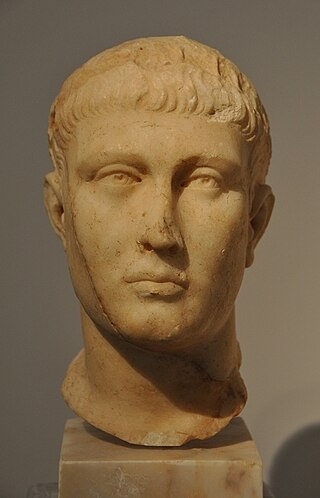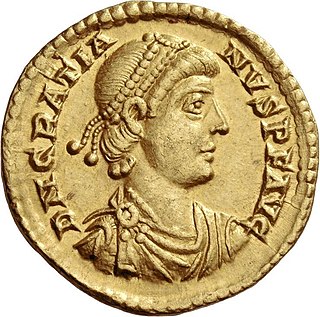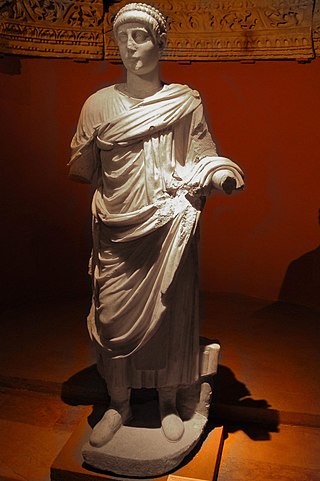
Honorius was Roman emperor from 393 to 423. He was the younger son of emperor Theodosius I and his first wife Aelia Flaccilla. After the death of Theodosius in 395, Honorius, under the regency of Stilicho, ruled the western half of the empire while his brother Arcadius ruled the eastern half. His reign over the Western Roman Empire was notably precarious and chaotic. In 410, Rome was sacked for the first time in almost 800 years.

Theodosius I, also called Theodosius the Great, was Roman emperor from 379 to 395. During his reign, he succeeded in a crucial war against the Goths, as well as in two civil wars, and was instrumental in establishing the creed of Nicaea as the orthodox doctrine for Christianity. Theodosius was the last emperor to rule the entire Roman Empire before its administration was permanently split between the West and East.

Valens was Roman emperor from 364 to 378. Following a largely unremarkable military career, he was named co-emperor by his elder brother Valentinian I, who gave him the eastern half of the Roman Empire to rule. In 378, Valens was defeated and killed at the Battle of Adrianople against the invading Goths, which astonished contemporaries and marked the beginning of barbarian encroachment into Roman territory.
The 380s decade ran from January 1, 380, to December 31, 389.

Year 383 (CCCLXXXIII) was a common year starting on Sunday of the Julian calendar. At the time, it was known as the Year of the Consulship of Merobaudes and Saturninus. The denomination 383 for this year has been used since the early medieval period, when the Anno Domini calendar era became the prevalent method in Europe for naming years.

Magnus Maximus was a Celtiberian who became Roman emperor of the Western Roman Empire from 383 to 388. He usurped the throne from emperor Gratian.

Gratian was emperor of the Western Roman Empire from 367 to 383. The eldest son of Valentinian I, Gratian was raised to the rank of Augustus as a child and inherited the West after his father's death in 375. He nominally shared the government with his infant half-brother Valentinian II, who was also acclaimed emperor in Pannonia on Valentinian's death. The East was ruled by his uncle Valens, who was later succeeded by Theodosius I.

Valentinian I, sometimes called Valentinian the Great, was Roman emperor from 364 to 375. He ruled the Western half of the empire, while his brother Valens ruled the East. During his reign, he fought successfully against the Alamanni, Quadi, and Sarmatians, strengthening the border fortifications and conducting campaigns across the Rhine and Danube. His general Theodosius defeated a revolt in Africa and the Great Conspiracy, a coordinated assault on Roman Britain by Picts, Scoti, and Saxons. Valentinian founded the Valentinianic dynasty, with his sons Gratian and Valentinian II succeeding him in the western half of the empire.

Valentinian II was a Roman emperor in the western part of the Roman empire between AD 375 and 392. He was at first junior co-ruler of his half-brother, was then sidelined by a usurper, and only after 388 sole ruler, albeit with limited de facto powers.
Flavius Theodosius, also known as Count Theodosius or Theodosius the Elder, was a senior military officer serving Valentinian I and the western Roman empire during Late Antiquity. Under his command the Roman army defeated numerous threats, incursions, and usurpations. Theodosius was patriarch of the imperial Theodosian dynasty and father of the emperor Theodosius the Great.

Victor was a Western Roman emperor from either 383/384 or 387 to August 388. He was the son of the magister militum Magnus Maximus, who later became a usurper of the Western Roman Empire, in opposition to Gratian. Maximus rose up in 383, and was recognized as the legitimate emperor in the west by Theodosius I. Victor was elevated to augustus of the Western Roman Empire in either 383/384 or mid-387, making him co-emperor with his father. Maximus invaded Italy in 387, to depose Valentinian II, the brother and successor of the late Gratian. Because of Maximus' invasion, Theodosius invaded the Western Empire in 388. Theodosius defeated Maximus in two battles in Pannonia, before crushing his army at Aquilea, and capturing Maximus. Maximus was executed on 28 August 388. His death was followed quickly by that of Victor, who was executed in Trier by the Frankish general Arbogast.

The Theodosian dynasty was a Roman imperial family that produced five Roman emperors during Late Antiquity, reigning over the Roman Empire from 379 to 457. The dynasty's patriarch was Theodosius the Elder, whose son Theodosius the Great was made Roman emperor in 379. Theodosius's two sons both became emperors, while his daughter married Constantius III, producing a daughter that became an empress and a son also became emperor. The dynasty of Theodosius married into, and reigned concurrently with, the ruling Valentinianic dynasty, and was succeeded by the Leonid dynasty with the accession of Leo the Great.

The Battle of the Frigidus, also called the Battle of the Frigid River, was fought on 5 and 6 September 394 between the armies of the Roman emperor Theodosius the Great and the rebel augustus Eugenius, in the eastern border of Roman Italy. Theodosius won the battle and defeated the usurpation of Eugenius and Arbogast, restoring unity to the Roman Empire. The battlefield, in the Claustra Alpium Iuliarum near the Julian Alps through which Theodosius's army had passed, was probably in the Vipava Valley – with the Frigidus River being the modern Vipava – or possibly in the valley of the Isonzo.

The Valentinianic or Valentinian dynasty was a ruling house of five generations of dynasts, including five Roman emperors during Late Antiquity, lasting nearly a hundred years from the mid fourth to the mid fifth century. They succeeded the Constantinian dynasty and reigned over the Roman Empire from 364 to 392 and from 425 to 455, with an interregnum (392–423), during which the Theodosian dynasty ruled and eventually succeeded them. The Theodosians, who intermarried into the Valentinian house, ruled concurrently in the east after 379.
Justina was a Roman empress. She was initially the wife of the rebel emperor Magnentius and was then married to Valentinian I, with whom she had four children, including the emperor Valentinian II and the empress Galla.
Arbogastes or Arbogast was a Roman army officer of Frankish origin.
Galla was a Roman empress as the second wife of Theodosius I. She was the daughter of Valentinian I and his second wife Justina.
Flavius Richomeres or Ricomer was a Frank who lived in the late 4th century. He took service in the Roman army and made a career as comes, magister militum, and consul. He was an uncle of the general Arbogastes. He is possibly to be identified with the Richomeres who married Ascyla, whose son Theodemer later became king of the Franks.
Flavius Merobaudes was a Roman army officer of Frankish origin. He was appointed magister peditum around 375, and consul twice in 377 and 383. Ancient sources record that he was put to death that year for his support of the imperial usurper Magnus Maximus, but an inscription records that he became consul a third time in 388.












